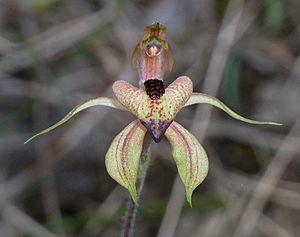Thick-lipped spider-orchid facts for kids
Quick facts for kids Thick-lipped spider-orchid |
|
|---|---|
 |
|
| Caladenia cardiochila near Anglesea | |
| Scientific classification | |
| Genus: |
Caladenia
|
| Species: |
cardiochila
|
| Synonyms | |
|
|
The Caladenia cardiochila, also known as the thick-lipped spider-orchid or heartlip spider-orchid, is a special type of plant in the orchid family. It grows only in Victoria and South Australia. This ground orchid has a single, fuzzy leaf and usually one or two flowers. These flowers are yellowish-green with red stripes and grow on a thin stem.
About the Thick-Lipped Spider-Orchid
The thick-lipped spider-orchid is a plant that grows from an underground part called a tuber. It is a perennial plant, meaning it lives for more than two years. It is also deciduous, so its leaves fall off at certain times.
It has one leaf that is about 4 to 11 centimeters (1.6 to 4.3 inches) long and 3 to 10 millimeters (0.1 to 0.4 inches) wide. This leaf is somewhat hairy and shaped like a narrow spear.
Flower Details
The plant usually has one or two flowers on a thin, slightly hairy stem that is 10 to 30 centimeters (3.9 to 11.8 inches) tall. The parts of the flower that look like petals are called sepals and petals. They are yellowish to greenish-pink with a red stripe in the middle. Sometimes, they can be all red.
The top sepal stands up or curves forward. It is about 15 to 30 millimeters (0.6 to 1.2 inches) long. The side sepals are similar in length but wider. They grow parallel to each other or sometimes cross over. The petals are narrower than the side sepals and spread out or curve downwards.
The most interesting part is the labellum, which is like a special lip. It is yellowish-green or cream-colored with red marks. The tip of the labellum is dark maroon or brown. It is shaped like a heart or a wide egg, about 10 to 20 millimeters (0.4 to 0.8 inches) long and 8 to 15 millimeters (0.3 to 0.6 inches) wide. The sides of this "lip" curve up slightly, and the tip curves down.
There are no jagged edges on the labellum. Instead, it has two or four rows of thick, club-shaped bumps called calli in the lower middle part. These bumps do not reach the very tip of the labellum. The flowers bloom from August to November.
This orchid looks a lot like another orchid called C. tessellata. However, Caladenia cardiochila usually has bigger flowers. Its labellum does not have teeth on the edge, and its calli do not reach the tip. Some plants might look like a mix of both, suggesting they could be related or even hybrids.
Naming and History
The Caladenia cardiochila was first officially described by a person named Ralph Tate in 1887. He wrote about it in a publication called Transactions, proceedings and report, Royal Society of South Australia. The plant he described was found near Golden Grove.
The scientific name cardiochila comes from two Ancient Greek words. Kardia means "heart," and cheilos means "lip." So, the name "heartlip" perfectly describes the shape of the orchid's labellum.
Where It Lives
This orchid grows either by itself or in small groups. It prefers sandy soils in areas with mallee heath, scrub, or forest. You can find it in western Victoria and the southeastern part of South Australia.
There was one record of this orchid on the northern part of Flinders Island in 1947. However, it is now thought to be extinct in that area.

